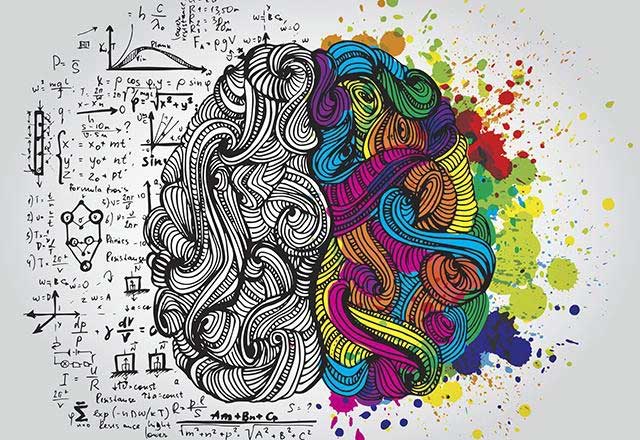According to research, human handedness may be influenced by genes and environmental factors during both the fetal stage and after birth. The development of the brain also plays a crucial role in determining human handedness.
Are left-handed individuals truly more creative? Brain wave scans may provide the answer.
Left-handed people tend to engage the right hemisphere of their brains more frequently, suggesting they approach problem-solving in a more creative manner.
Scientists have studied human handedness for over a century, and their discoveries reveal much about how the human brain can function differently.
For a long time, many sources have claimed that left-handed individuals always possess some kind of strength or talent. But is that really the case?
The Brains of Left-Handed and Right-Handed People Are Different
In fact, the brains of left-handed individuals differ from those of right-handed individuals.
Specifically, according to Eric Zillmer, a professor of neuropsychology at Drexel University, left-handed individuals are less likely to exhibit a phenomenon known as lateralization compared to right-handed individuals.
Lateralization is the theory that the human brain is divided into two hemispheres—the left hemisphere and the right hemisphere—each responsible for distinct functions.

Left-handed individuals tend to engage the right hemisphere more frequently.
The left hemisphere is usually associated with speech, writing, arithmetic, language, and comprehension, while the right hemisphere controls creativity, musical skills, and artistic abilities.
If a researcher begins a conversation with you and scans your brain using fMRI during this process, the left hemisphere (associated with language) will typically show greater activity than the right hemisphere. This is what researchers have observed in most right-handed individuals—when it comes to language-related tasks, the left hemisphere is more active than the right.
However, scientists have discovered the opposite is true for most left-handed individuals.
Most left-handed individuals exhibit greater activity in their right hemisphere for language tasks. Because left-handed people rely less on their left hemisphere, researchers interpret this as meaning they are less likely to experience lateralization.
Moreover, the left and right hemispheres differ not only in language aspects.
A 2010 study on handedness and facial recognition revealed that left-handed individuals engage both hemispheres when looking at a face. In contrast, right-handed individuals primarily process facial recognition in the right hemisphere.
What does this have to do with creativity?
Zillmer noted that differences in lateralization may enable left-handed individuals to think in more unconventional ways, giving them a creative advantage.

Left-handed individuals think in more unconventional ways, gaining a creative advantage.
Creativity May Come More Naturally to Left-Handed Individuals
Perhaps the most compelling studies linking handedness and creativity involve individuals with high schizotypy—traits resembling schizophrenia but less severe.
In the early 2000s, several research groups found an intriguing correlation between highly creative individuals—such as professional musicians and visual artists—and high levels of schizotypy.
Furthermore, individuals with pronounced schizophrenia also exhibited greater right hemisphere activity for tasks typically associated with the left hemisphere—similar to what is observed in left-handed and ambidextrous individuals.

The right hemisphere is related to analytical thinking.
Therefore, if individuals with high schizotypy are more creative, it may imply that left-handed individuals could also be more creative than their right-handed counterparts. Of course, more research is needed to substantiate this theory.
It’s important to note that the right hemisphere is associated with analytical thinking—meaning the ability to creatively devise unique solutions to specific problems. Thus, if left-handed individuals tend to engage that area of the brain more frequently, it suggests they are also more inclined to solve problems creatively.
The possibility that left-handed individuals are more creative may also stem from their constant need to adapt to a world primarily designed for right-handed individuals.
Katina Bajaj, a clinical psychology researcher and co-founder of Daydreamers, noted that this inadvertently creates opportunities for left-handed individuals to use their imagination more often, thereby nurturing their creative abilities.

Approximately 10% of the population is left-handed.
Bajaj stated: “Our creative brain is activated when we engage in new, novel experiences. Because left-handed individuals must continually adjust in a world dominated by right-handed people, they have to use their imagination more, and over time, they become better at imagining and creating.”
Why Are There Left-Handed Individuals?
Researchers do not yet know exactly why about 10% of the population is left-handed. However, some studies have suggested how and when handedness is determined.
In one study, researchers found they could reasonably predict a child’s handedness by observing which hand they preferred to move while still in the womb.
A more recent study in 2020 discovered that handedness is at least partially determined by genetics and may be entirely genetically driven.
However, environmental factors cannot be overlooked, Zillmer noted. For instance, a child with left-handed parents might also be left-handed due to mimicry, regardless of which hand they preferred to move while in the womb.

Handedness is at least partially determined by genetics.
Similarly, the same applies to creativity: “Many studies indicate that some individuals are born with a higher level of openness than others,” Bajaj said. “In my view, the more we cultivate creativity, the more it tends to flourish.”
Ultimately, if you want to become more creative, practice. If you want to use your left hand more often, practice. With enough willpower, your brain will be entirely under your control.


















































